<!--<!--<!--<!--
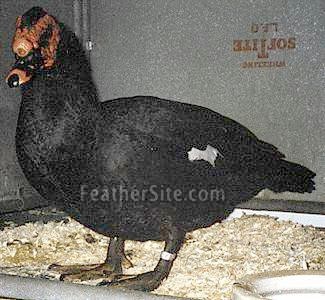
A Black Muscovy drake
The Muscovy Duck (Cairina moschata) is a large duck which is native to Mexico and Central and South America. A small wild population reaches into the United States in the lower Rio Grande Valley of Texas. There also are feral breeding populations in North America in and around public parks in nearly every state of the USA and in the Canadian provinces; feral populations also exist in Europe. Although the Muscovy Duck is a tropical bird, it adapts to icy and snowy conditions down to –12°C (10°F) and below without ill effects
The Muscovies original name was "Musco Duck", because it is known as the "Mosquito Duck", for eating Mosquitoes. The Russain Muscovites was one of the first to import them. One of the main reasons they were brought here several hundred years ago, is to help keep down the mosquito and bug population, and that they do, and do it well. There are billions of insects on a acre of land, and the muscovy ducks are worth their weight in gold at eating Mosquitoes and insects. They eat the mosquito larva right in the water, and they nip in the air and eat the ones flying around. They love roaches and eat them like they are candy, they eat flies, and maggots and do a lot to keep down the fly population. They even eat those rolly pollies that you find under rocks and all around the outside of your house. They have a bad taste, and most birds won't even eat them, the Muscovies are one of the few things that will eat them. But what even makes them more valuable is they love spiders, and they eat even the poisonous ones, the Black Widow, and the deadly brown spider that is worse than the Black Widow. It is quite common in Florida. They are in our garages, around our house,(some are right in our homes) under our picnic tables, all around us, and the Muscovy Ducks have saved many peoples lives from spider bites and people don't even know it. They should have these ducks in all parks for these reasons. They go under the bridges and picnic tables where kids play, and reach up in the corners and crevices and eat the spiders, along with other insects, making them more valuable than people will ever know.
Muscovies are the only domestic ducks that are not derived from Mallard stock. They are a South American species. The original (wild type) coloration is black and white, but domestication has produced many more colors, including white, black, chocolate, and blue. The males are large, weighing up to twelve pounds, with the smaller females reaching only seven. Their feet have strong sharp claws and are built to grasp, so that they can perch on branches. Some people consider them ugly because of the large red warty caruncles above the beak and around the eyes. They are, however, very personable and interesting birds, and quite intelligent. Unlike most domestic waterfowl, Muscovies will often fly up and roost. They fly fairly well, especially the smaller females, but are known more for flying around than flying away!
The meat of the Muscovy is unlike that of the other domestic ducks. It is not greasy and is much more like veal than like poultry. In Taiwan and Europe they often use the Mule Duck, a hybrid of the Muscovy with Mallard-derivatives, as a meat bird
By the age of three months or so, the males are nearly twice as large as the females
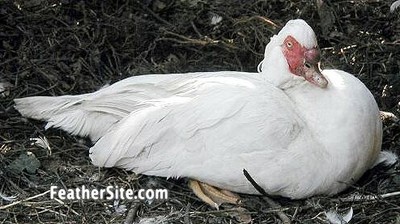
white Muscovy drake from Belgium
Scientific classification
Kingdom: Animalia
Phylum: Chordata
Class: Aves
Subclass: Neornithes
Infraclass: Neognathae
Superorder: Galloanserae
Order: Anseriformes
Family: Anatidae
Genus: Cairina
Species: C. moschata
Binomial name Cairina moschata
Many farms use the muscovies to help control the bugs, flies, mosquitos, and weeds on their farm. Muscovy Ducks also come in handy on farms because they go around and eat all the excess food laying around that can draw rats. They also come in handy so the farmer can give them the left over food of the chickens or other fowl. The Muscovies even help keep down the rats because of eating the left over food, then there is none to draw the rats in the night to eat it. The Muscovies have it all gone by the time night falls. They also come in handy because they eat the roaches and other bugs all over the place.
Many people do not know it, but, Florida is crawling with rats. Rats are all over Florida, even in the rich areas. There are many different types here also, hugh ones, burrowing ones, regular ones, etc. The Muscovies help very much to keep them down
Description
Muscovy ducks are unique because of their bright red crest around their eyes and above the beak. They do not swim much because their oil glands are under developed compared to most ducks. Muscovy hens can set three times a year, and the egg clutches can vary from 8 to 21 eggs. The egg are incubated for 35 days
All Muscovy Ducks have long claws on their feet and a wide flat tail. The drake (male) is about 86 cm long and weighs 4.6-6.8 kg (10-15 lb), while the hen (female) is much smaller, at 64 cm in length and 2.7-3.6 kg (6-8 lb) in weight; domesticated males often weigh up to 8 kg (17 lb), and domesticated females up to 5 kg (10 lb). One male of an Australian breed weighed about 10 kg (20 pounds
The wild Muscovy Duck is blackish, with large white wing patches. Domesticated birds may look similar; most are dark brown or black mixed with white, particularly on the head. Other colors such as lavender or all-white are also seen. Both sexes have a nude black-and-red or all-red face; the drake also has pronounced caruncles at the base of the bill and a low erectile crest of feathers
C. moschata ducklings are mostly yellow with buff-brown markings on the tail and wings. Some domesticated ducklings have a dark head and blue eyes, others a light brown crown and dark markings on their nape. They are agile and speedy precocial birds
The drake has a low breathy call, and the hen a quiet trilling coo
The karyotype of the Muscovy Duck is 2n=80, consisting of three pairs of macrochromosomes, 36 pairs of microchromosomes, and a pair of sex chromosomes. The two largest macrochromosome pairs are submetacentric, while all other chromosomes are acrocentric or (for the smallest microchromosomes) probably telocentric. The submetacentric chromosomes and the Z (female) chromosome show rather little constitutive heterochromatin (C bands), while the W chromosomes are at least two-thirds heterochromatin
Male Muscovy Ducks have spiralled penises which can become erect to 20 cm in one third of a second. Females have cloacas that spiral in the opposite direction to try and limit forced copulation by males
Domestic varieties
- Black
- Blue
- Chocolate
- Pied (white with any color)
- White
- Lavender
- Bronze
- Barred
- Ripple
- and many more pastel colors but these are very rare.
Head shot of a Muscovy Duck
Reproduction
This species, like the Mallard, does not form stable pairs. They will mate on land or in water (note the submerged female in the image below). Domesticated Muscovy Ducks can breed up to three times each year
The hen lays a clutch of 8-16 white eggs, usually in a tree hole or hollow, which are incubated for 35 days. The sitting hen will leave the nest once a day from 20 minutes to one and a half hours, and will then defecate, drink water, eat and sometimes bathe. Once the eggs begin to hatch it may take 24 hours for all the chicks to break through their shells. When feral chicks are born they usually stay with their mother for about 10–12 weeks. Their bodies cannot produce all the heat they need, especially in temperate regions, so they will stay close to the mother especially at night
Often, the drake will stay in close contact with the brood for several weeks. The male will walk with the young during their normal travels in search for food, providing protection. Anecdotal evidence from East Anglia, UK suggests that, in response to different environmental conditions, other adults assist in protecting chicks and providing warmth at night. It has been suggested that this is in response to local efforts to cull the eggs, which has led to an atypical distribution of males and females as well as young and mature birds
For the first few weeks of their lives, Muscovy duckling feed on grains, corn, grass, insects, and almost anything that moves. Their mother instructs them at an early age how to feed
Mule Duck

Mule Duck
Lean Mule Ducks
The recent introduction of mule ducks by the French breeder Grimaud Freres brings to mind the long history of mule production in Taiwan. Admittedly the familiar White Pekin is the most popular meat duck in the world but interest in leaner ducks should not come as a surprise. Until now the preference of the French for leaner duck meat has been met by the Muscovy which they call Canard de Barbarie. The Taiwanese have preferred to produce lean mule ducks to avoid the problems involved in breeding Muscovies
The mule ducks are the sterile progeny from a cross of two species in which common duck females (Anas platyrynchos) are inseminated by semen from Muscovy drakes (Cairina moschata). In Taiwan the female parent of the mule is the Kaiya, a cross of Pekin drake with the Tsiaya, the Taiwanese egg-laying breed. This produces a market duck with extremely lean meat; a fat content of less than 18% as compared to 30% of more fat content of purebred Pekin ducks
One must admit that the meat of a purebred Muscovy is just as lean as the meat of a Taiwan mule and the Muscovy is actually more meaty. But the mules have two important advantages: first, because there is a disparity in size between the sexes of Muscovies (female Muscovy ducklings are only 60% as large as males at market age). This presents a problem because when the females are heavy enough to market, the males are too large. And second, that duck mother of the mule lays many more eggs than the Muscovy females. (After laying a clutch of eggs muscovies become broody, unless kept in a windowless house with a carefully controlled environment. This technique was developed in France and is, unfortunately, not feasible for warmer countries)
Because of the low egg production of Muscovy females and the slow rate of growth of the female ducklings meat produced by purebred Muscovies is expensive to produce. By contrast, meat produced by the Taiwan mule duck is very competitive in cost because it exploits the best features of each parent. The mother is an egg laying machine which will produce 250 eggs per year under ordinary management and she is never broody. She is particularly well adapted to artificial insemination. Male and female mules inherit the good breast fleshing of their Muscovy father but, more to the point, female mule ducks grow as fast and as large as their brothers. Why? Because they are genetic castrates; the mule female has no functional ovary and thus growth is not inhibited ovarian secretions
Moreover, mule ducklings are easy to raise. They are calm and exceptionally tame. In contrast to the nervous, noisy Pekin, mules are completely silent. Mules swim, an important trait for cooling in hot weather, but do not fly. Mules can be confined by a fence less than half a meter in height.
Mule ducks take about two weeks longer to attain market weight than the Pekin but the extra cost can be partially offset by the use of lower energy feedstuffs. Actually, their slower growth may be an advantage; many Chinese believe that the flesh of older birds is firmer and therefor more tasty. If the shrink in weight in cooking due to the high fat content of Pekins is considered, there is no difference in efficiency between them and mules
Mule ducks have been grown in Taiwan for more than 275 years. Until recently the parents were hand mated to overcome the problem of poor fertility of eggs from natural matings of Muscovy males and common ducks. The farmer stood in the water of the pond (two times each week) and held the duck for the male! Nowadays artificial insemination is used, made possible by the invention of an artificial vagina in Japan about twenty years ago
Mule ducks are popular in other countries of Southeast Asia but they are all produced from preincubated hatching eggs shipped to them from Taiwan. Preincubated? Eggs that hatch mules require 32 days of incubation. Such eggs are set in incubators in Taiwan and incubated for 28 days. They are then candled to remove infertile eggs and eggs with dead embryos and packed in plastic boxes to be shipped by air to dealers in other countries. The dealer puts the eggs on a table and covers them with a blanket -- two days later he has duckling to sell. (Originally the preincubated eggs were shipped by boat. The Taiwanese love to tell of the salutary effects of the sea voyage on hatchability)
The Need for a White-feathered Mule
The French will tolerate black pinfeathers as evidence of the bird being rustic but the Chinese demand a cleanly picked bird. Therefore the plumage of a bird must be white or the pin feathers become more prominent and some residual black pigmentation may appear on the skin. Producing a mule with white plumage presents an interesting problem in the genetics of plumage color. The genes fro white in both species are recessive but they are NOT homologous, i.e., they are not located in the same place on the same chromosome. In this case a mating of two white birds produces colored progeny because the genes for color previously hidden under the recessive white will appear
The Taiwanese have solved this problem in two distinctly different ways: 1. By breeding a recessive white with favorable cryptomeres and 2. by ingeniously exploiting the dominant "white runner" usually seen in Indian Runner ducks
Breeding a Suitable Recessive White
The plumage of the indigenous egg-producing duck of Taiwan is a buff color but the Taiwanese have never felt the need to eliminate mutant colors which appear among them. Thus a pure breeding recessive white variety could be made in a single generation by simply selecting yellow duckling for breeders. But as far as I know the hypostatic color genes of the recessive white bird now in use remain to be determined
When mated to Muscovy males his newly developed recessive white Tsiaya solved the problem of producing mule ducklings with white plumage. But, after the introduction of the large White Pekin ducks to the market it became apparent that a larger white mule duckling was required. The white Tsiaya was first crossed with a White Pekin male to increase the size of the Kaiya, the mother of the mule. Unfortunately the Pekin introduced the genes from colored plumage hidden by his recessive plumage and many of these mule ducklings were colored instead of white
Apparently only one private breeder succeeded in eliminating these hidden genes for color in a recessive white Kaiya. His birds are completely white except for just a hint of buff rustiness on the flight feathers. His method is a trade secret but I suspect this rustiness is due to lack of hidden genes for black and that he may also have utilized the dominant gene for black as described in the following section
Breeding the Pied Runner Tsiaya
This ingenious solution to the problem of eliminating colored feathers in mule ducks was developed by two Taiwanese duck breeders each working independently but with the same genetic material (and with a little luck). They made a new pied variety of Tsiaya from the dominant white ducks which occasionally appear among the buff Tsiaya. These ducks can be readily identified because while mostly white they have some black feathers in the face and head. This pattern is the expression of the incompletely dominant gene for white which is involved in the pattern of the Indian Runner breed
But mule ducklings from the "Runner" Tsiaya were too small so, as in the recessive white variety, white Pekin males were crossed on Runner Tsiaya females to produce the mother of the mule.
The Pekin Grandfather
This is where the Taiwan breeders got lucky. As we have seen, use of a white Pekin introduces genes for color which are normally hidden by recessive white. By chance, the Pekin these breeders used happened to also carry the dominant white runner gene so that, when crossed on pied Tsiaya, the progeny were pied. When these pied females were mated to white Muscovy males black down color in mule ducklings was all but eliminated
These breeders believe that this white Pekin had originally come from Denmark. Even now they plead with me to help find more (and bigger) white Pekins of that strain. I have not found anyone in Denmark who knows of this special white Pekin. My duck breeder friend were just lucky

A Bronze Muscovy drake from Australia
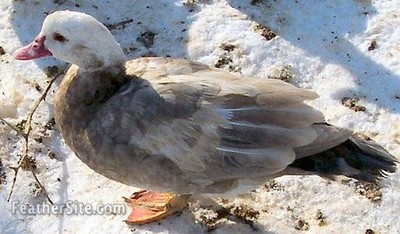
A female Chocolate Pied Muscovy
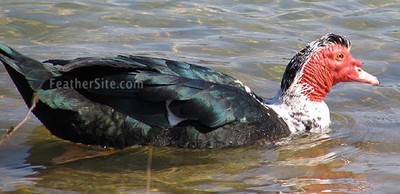
A Muscovy drake swimming
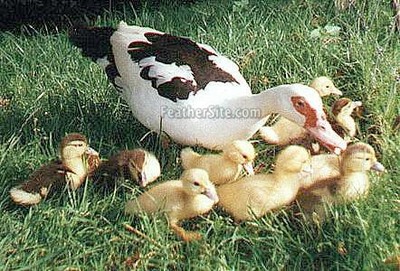
A Muscovy Duck with her brood
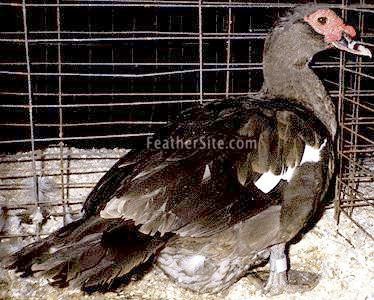
Chocolate Muscovies
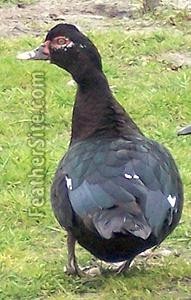
Wild Muscovy hen
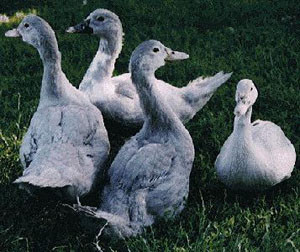
Lavmus Muscovy
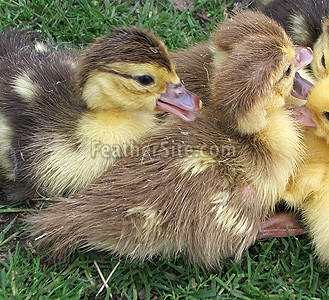
Chocolate Muscovy ducklings
<!--[if !mso]> <mce:style><! v\:* {behavior:url(#default#VML);} o\:* {behavior:url(#default#VML);} w\:* {behavior:url(#default#VML);} .shape {behavior:url(#default#VML);} -->
<!--[endif] --><!--<!--<!--[if gte mso 10]> <mce:style><! /* Style Definitions */ table.MsoNormalTable {mso-style-name:"Table Normal"; mso-tstyle-rowband-size:0; mso-tstyle-colband-size:0; mso-style-noshow:yes; mso-style-priority:99; mso-style-qformat:yes; mso-style-parent:""; mso-padding-alt:0cm 5.4pt 0cm 5.4pt; mso-para-margin-top:0cm; mso-para-margin-right:0cm; mso-para-margin-bottom:10.0pt; mso-para-margin-left:0cm; line-height:115%; mso-pagination:widow-orphan; font-size:11.0pt; font-family:"Calibri","sans-serif"; mso-ascii-font-family:Calibri; mso-ascii-theme-font:minor-latin; mso-hansi-font-family:Calibri; mso-hansi-theme-font:minor-latin;} -->
<!--[endif] -->

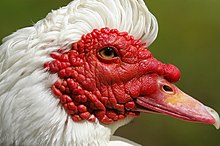



ساحة النقاش